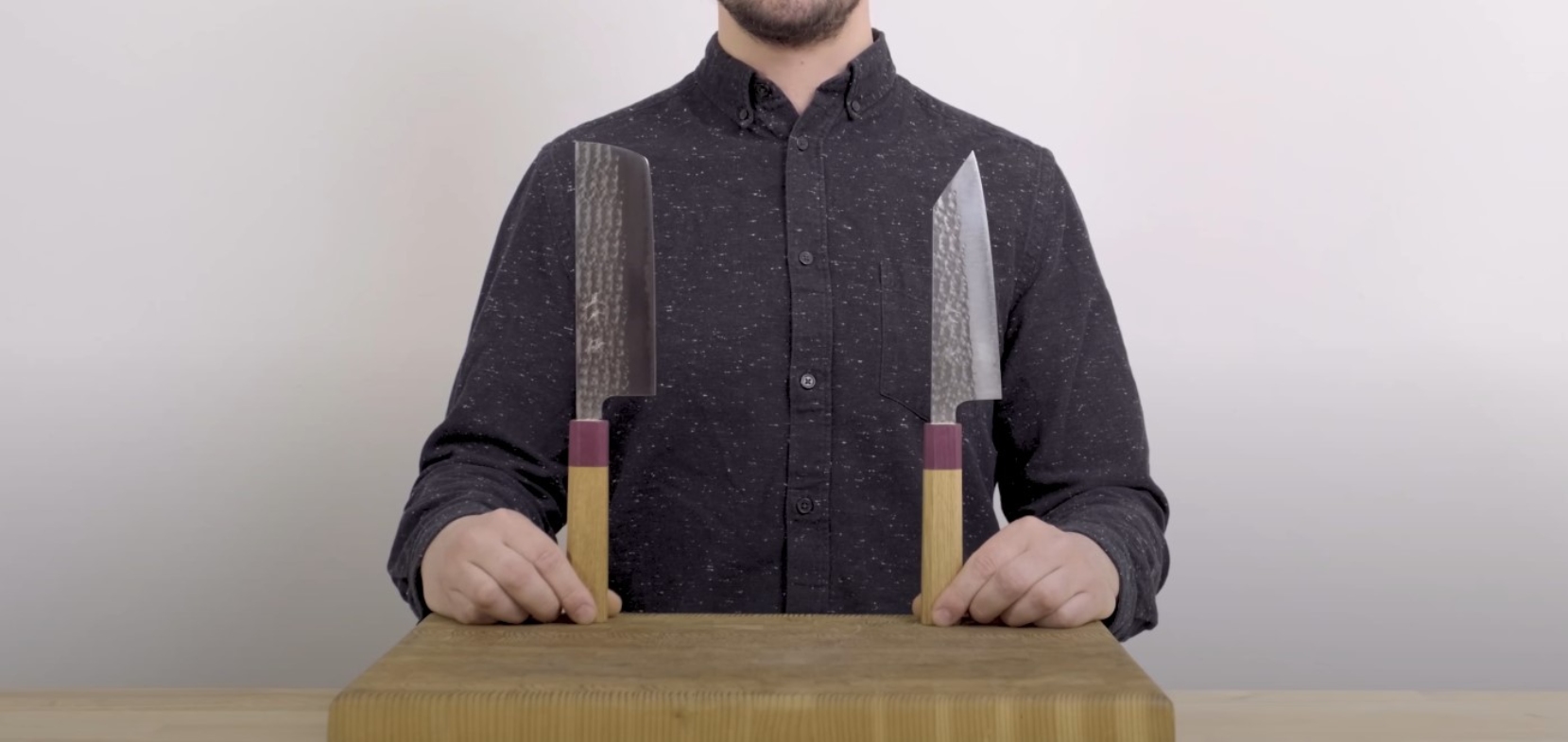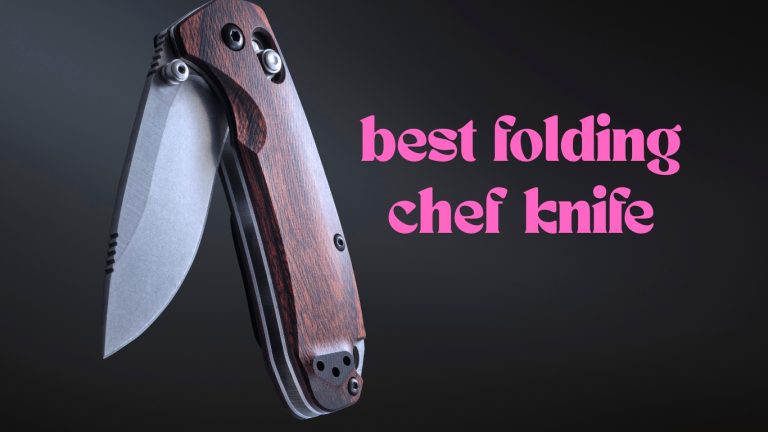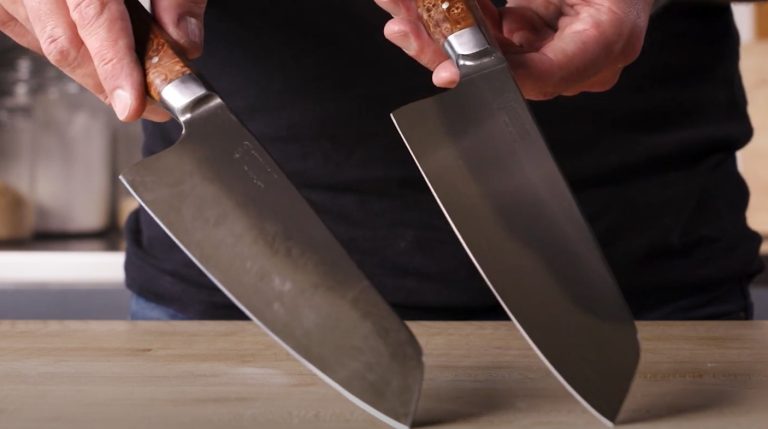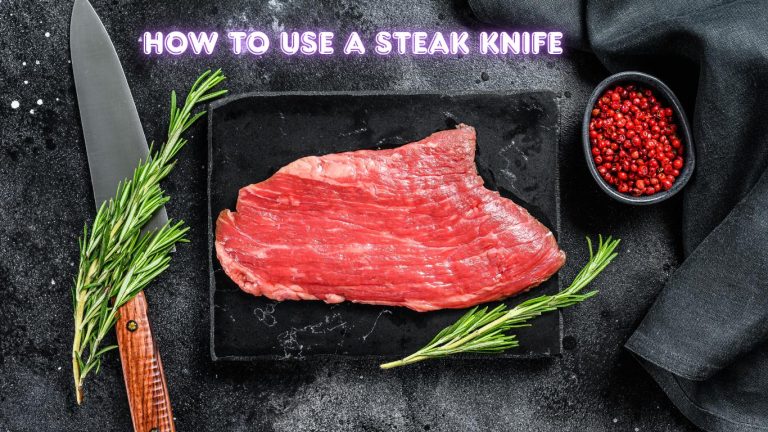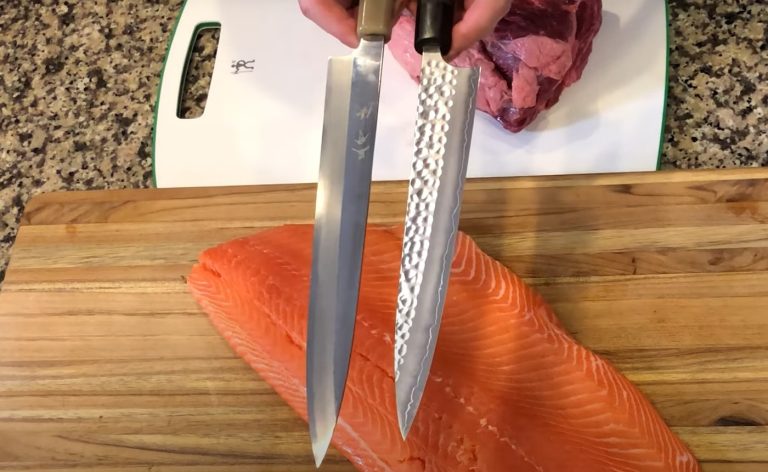Bunka vs Nakiri: Battle of the Blades
When choosing between a Bunka and a Nakiri, you’re picking between versatility and specialization. The Bunka, a post-WWII all-rounder, handles meat, fish, and veggies with its sharp K-tip for precision.
The Nakiri, a traditional veggie expert, shines with a flat, wide blade for clean, uniform chops. Whether you’re a beginner or advancing, each offers unique strengths for your kitchen tasks.
Stick around to uncover which suits your cooking style best.
Key Takeaways
- Bunka is a versatile all-rounder for meat, fish, and vegetables, while Nakiri specializes in precise vegetable chopping.
- Bunka’s K-tip offers precision for intricate cuts, unlike Nakiri’s blunt, squared-off tip for full board contact.
- Nakiri excels in straight up-and-down vegetable slicing, whereas Bunka supports varied techniques like rocking and slicing.
- Bunka adapts to diverse tasks and textures, while Nakiri is limited to produce-focused preparation.
- Nakiri is beginner-friendly with intuitive chopping, but Bunka suits advancing skills with its versatile design.
Bunka and Nakiri Knives Overview
When you’re exploring the world of Japanese kitchen knives, the Bunka and Nakiri stand out as two distinct tools with rich histories and specialized purposes. This design enables rock chopping motions, making it versatile for meats and vegetables.
The Bunka, meaning “culture,” emerged post-WWII to adapt to a changing diet, offering versatility for meat, fish, and veggies.
The Bunka, translating to “culture,” was born post-WWII, evolving to handle a diverse diet of meat, fish, and vegetables with ease.
You’ll find it excels at chopping, dicing, and precision tasks, thanks to its pointed tip, with blade lengths often around 165mm.
Meanwhile, the Nakiri, or “leaf cutter,” is a time-honored vegetable specialist, ideal for home cooks.
Its thin, tall blade, typically 165-180mm, slices through greens and hard veggies with a clean up-and-down chop.
While you can use both for push-cutting, the Bunka’s multi-use design contrasts with the Nakiri’s focused veggie prowess.
This adaptability of the Bunka reflects its design for evolving Japanese diets after the war.
Blade Design and Shape Comparison
Diving into the blade design of Bunka and Nakiri knives, you’ll quickly notice how their shapes define their unique strengths. The Bunka boasts a sharp, angular K-tip, perfect for precision tasks like scoring or piercing.
These knives are often made from high-carbon stainless steel, which ensures their exceptional sharpness and durability. In contrast, the Nakiri’s blunt, squared-off tip provides full board contact with its flat edge, ideal for clean, straight cuts.
Look at their profiles: the Nakiri’s rectangular, wide blade and straight spine contrast with the Bunka’s angular shape, where the spine slopes to that distinct tip. Additionally, the Bunka’s design features a reverse tanto tip, which enhances its suitability for intricate cuts and detailed work.
Both offer great knuckle clearance with tall blades, often 160-180mm long.
While Nakiri blades are typically thinner for gliding through veggies, Bunkas might’ve a thicker spine for versatility.
Their wide designs also make scooping ingredients a breeze.
Cutting Techniques and Styles
Take a closer look at how Bunka and Nakiri knives shine through their distinct cutting techniques and styles. You’ll notice the Nakiri excels with push-cutting and vertical chopping, ensuring clean, uniform vegetable cuts with its flat edge.
Meanwhile, the Bunka offers versatility with push-cutting, tap-chopping, and slicing, aided by its K-tip for precision and slight curve for rocking. This versatility in the Bunka knife mirrors the benefits of curved blades in providing enhanced control for precise cuts.
The Bunka’s design also allows for intricate cuts with fine edge, making it ideal for detailed work on various ingredients.
Primary Uses in the Kitchen
When you’re tackling kitchen tasks, you’ll find the Bunka’s versatility shines as it handles everything from slicing meat to mincing herbs with ease, making it a true all-rounder. The Bunka’s design also supports push/pull cuts, enhancing its adaptability for various techniques.
On the other hand, the Nakiri’s razor-sharp, straight edge focuses on vegetable prep, letting you chop and dice with precision and speed.
Let’s explore how these strengths impact efficiency for different recipes and cooking styles, helping you pick the right blade for your needs. Additionally, the Bunka’s pointed tip and curved belly make it ideal for intricate tasks and rocking motions during cutting.
Bunka’s Versatile Cutting
Imagine a single knife that can tackle almost any kitchen task with finesse—that’s the Bunka for you.
This multi-purpose Japanese blade, with its distinct K-tip, handles everything from slicing meat and fish to chopping herbs with ease. Its double bevel design makes it accessible for both left and right-handed users, ensuring comfort during extended use.
You’ll love how its straight edge excels at tap-chopping and push-cutting, while the sharp, thin profile guarantees clean, swift cuts every time.
Beyond basics, the Bunka’s K-tip shines for precision work.
Use it to mince garlic finely, score delicate patterns, or trim fat with accuracy.
Whether you’re dicing starchy veggies or preparing sashimi, this all-purpose workhorse adapts effortlessly.
Even the smaller Ko-Bunka retains this versatility, making it perfect for in-hand cutting or as a handy utility knife on your board.
Its lightweight design makes it especially comfortable for users with smaller hands or in compact kitchen spaces lightweight design.
Nakiri’s Vegetable Focus
A Nakiri knife is your ultimate ally for vegetable preparation, designed specifically as a “leaf cutter” with its rectangular, thin, and wide blade. Additionally, the Nakiri can help achieve the same results as a julienne peeler for shredding carrots effectively.
You’ll love how its straight, flat edge delivers precise, uniform cuts, whether you’re julienning carrots or dicing squash. The large surface area provides even pressure, making quick work of leafy greens like cabbage or delicate herbs without bruising them.
With a vertical chopping motion, you can slice through hard root veggies or tender tomatoes cleanly, avoiding those pesky “accordion” cuts. Its double bevel design ensures that it’s suitable for both left-handed and right-handed users, enhancing its versatility in the kitchen double bevel design.
The tall blade offers knuckle clearance, so you’re safe while prepping. While it’s not for bones or thick skins, your Nakiri excels at handling most vegetables and even fruits like watermelon with ease.
Comparing Task Efficiency
Dive into the kitchen showdown between the Bunka and Nakiri as we compare their task efficiency for primary uses. This versatility is enhanced by the use of durable steels like VG10 steel.
You’ll find the Bunka’s versatility shines as an all-rounder, handling slicing, dicing, and chopping across veggies, fish, and meat with ease.
Its K-tip offers precision for fine mincing and intricate cuts, while a slight belly aids rocking motions.
On the other hand, the Nakiri’s flat, wide blade excels in straight up-and-down chopping, delivering clean, uniform vegetable slices.
You can chop high volumes of onions or carrots efficiently, and its broad surface scoops ingredients effortlessly.
Additionally, the Nakiri’s design, with lengths typically between 165-180mm, ensures optimal control during precise vegetable preparation tasks.
While the Bunka adapts to varied styles, the Nakiri’s your go-to for dedicated veggie prep with unmatched push/pull precision.
Versatility Across Different Ingredients
When exploring the versatility of kitchen knives, you’ll quickly notice the distinct strengths of the Bunka and Nakiri across various ingredients. For optimal performance, proper sharpening techniques, such as maintaining a consistent sharpening angle, can enhance their handling of different tasks.
The Bunka shines as a true all-rounder, adept at handling meat, fish, vegetables, and herbs with ease.
Its adaptability makes it a go-to for diverse textures, from starchy veggies to smaller proteins.
Additionally, the Bunka’s unique ‘K-tip’ design enhances precision for delicate tasks like trimming unique ‘K-tip’ design.
On the other hand, the Nakiri’s your vegetable specialist, excelling with clean, straight cuts on greens, roots, and fruits.
Here’s how they compare:
- Bunka: Tackles meat, fish, and veggies, bridging gaps between specialized knives.
- Nakiri: Dominates vegetable prep with its flat, thin blade for uniform cuts.
- Versatility Edge: Bunka wins for mixed tasks; Nakiri’s limited beyond produce.
Precision and Detail Work Capabilities
Diving into the precision and detail work capabilities of the Bunka and Nakiri, you’ll find stark contrasts in their design and performance.
With its unique ‘k-tip’ point, the Bunka gives you exceptional control for intricate tasks like brunoise cuts, scoring veggies, or mincing garlic. For optimal performance in these tasks, the Bunka should be sharpened at 15 degrees to maintain its edge sharpness.
You’ll excel at delicate work, from decorative cuts to trimming proteins with precision. The Bunka’s reverse Tanto profile further enhances this precision for intricate tasks.
On the flip side, the Nakiri’s flat, rectangular blade shines in precise vegetable chopping with full board contact for clean, uniform julienne or allumette cuts.
However, without a sharp tip, you’ll struggle with piercing or detailed ‘tippy’ tasks like slicing near an onion’s root.
Ease of Use for Different Skill Levels
Moving from precision in cuts to how these knives feel in your hands, let’s explore their ease of use across different skill levels.
If you’re a beginner, the Nakiri’s intuitive up-and-down chopping and wide blade offer safety and simplicity for veggie prep. This adaptability can be compared to the boning knife‘s strength in handling tougher tasks with precision.
The Bunka, with its pointed tip and versatile design, might challenge you initially but shines as you grow into varied tasks like meat or fish.
Consider these key differences:
- Nakiri’s Simplicity: You’ll master its flat edge for clean chops with minimal effort.
- Bunka’s Adaptability: You can tackle diverse cuts, ideal as your skills advance.
- Skill Progression: Choose Nakiri for focused veggie work or Bunka for an all-purpose edge.
Additionally, the Nakiri’s double-bevel blade makes it easier to handle for both right- and left-handed users double-bevel blade.
Material and Construction Differences
As you explore the nuances between Bunka and Nakiri knives, you’ll notice distinct differences in their material and construction that impact performance and feel.
Both knives often use high-quality Japanese steels like VG-10 or Shirogami, balancing sharpness with durability.
You’ll find Nakiri blades typically thinner, while Bunka can have moderate thickness or even “laser” thin designs.
Handles also vary—opt for a lightweight Wa handle in wood for a blade-forward balance, or a heavier Yo handle with full tang for stability.
Both can feature Kasumi construction, layering a hard core with softer cladding for resilience.
With hardness ratings often between 58-62 HRC, you’re assured of excellent edge retention.
Additionally, Nakiri knives are designed with a straight, rectangular blade for precise vegetable cuts.
Ideal Kitchen Scenarios for Each Knife
Have you ever wondered which knife suits your kitchen tasks best?
Let’s delve into the ideal scenarios for the Bunka and Nakiri.
If you’re tackling a mix of ingredients, the Bunka’s versatility shines with meat, fish, and veggies, especially for precise cuts like slicing raw fish or mincing garlic. Its balanced weight distribution ensures comfortable grip during extended use.
The Bunka knife excels with diverse ingredients, offering precision for slicing fish or mincing garlic with effortless versatility.
Meanwhile, the Nakiri’s your go-to for vegetable prep, excelling at rapid chopping of onions or delicate slicing of tomatoes.
Here’s when to grab each knife:
- Bunka: Opt for this all-rounder when you’re julienning, scoring, or handling light butchery with its sharp, angled tip.
- Nakiri: Choose this for high-volume veggie tasks, ensuring clean, even cuts with its straight edge.
- Task Match: Match your prep—detailed work with Bunka, veggie-heavy with Nakiri.
Frequently Asked Questions
How Do Bunka and Nakiri Differ in Weight?
Hey, let’s delve into knife weight differences!
You’ll notice that weights can vary based on design.
Typically, you’re looking at lighter builds for agility, often between 4-7 ounces.
Check the blade thickness and materials—thinner steel feels nimbler, while handles impact balance too.
When comparing, you’ll find Bunka often ranges 5-7 ounces, while Nakiri sits around 4-6 ounces, though specific models might overlap depending on the maker’s style.
Are Bunka and Nakiri Suitable for Left-Handers?
Hey, did you know that over 10% of the world’s population is left-handed?
If you’re one of them, you’ll be glad to hear that many Japanese knives are designed with you in mind.
Most feature double-bevel blades, ensuring ambidextrous use with symmetrical grinds.
Check for 50/50 bevels and symmetrical handles like octagonal or oval shapes.
You’ll find these knives comfortable and precise, perfectly suiting your left-handed grip!
What Is the Typical Cost Difference Between Them?
Hey, you’re probably wondering about the typical cost differences between certain kitchen knives.
Let’s jump in!
You’ll find that price gaps often aren’t huge and depend more on materials, craftsmanship, and brand than specific designs.
Expect similar ranges, from budget-friendly under $100 to premium pieces over $500.
Check steel types and finishes—those drive costs up more than shape.
How Do Their Handle Designs Compare Ergonomically?
Hey, let’s delve into how handle designs stack up ergonomically!
You’ll notice Japanese Wa-handles are lighter with a blade-forward balance, often in D-shape or octagonal for precise control.
Western Yo-handles, though, feel heavier with full tang construction, offering stability and a contoured grip.
Depending on whether you’re using a pinch grip or full handle hold, you’ll find one suits your style better for comfort and efficiency.
Can Both Knives Handle Frozen Foods Safely?
You might think a sharp knife can tackle anything, even frozen foods, but don’t be fooled! When you’re eyeing those icy blocks, know that most Japanese knives aren’t built for this.
Their hard, thin blades risk chipping or snapping under the strain.
Steer clear of using them on frozen items—opt for a sturdy cleaver or let food thaw a bit. Protect your blade, and cut smart!
Slice with Purpose, Cook with Passion
Hey, you’ve journeyed through the sharp world of Bunka and Nakiri knives, each a trusty steed in your culinary quest.
Whether you wield the versatile Bunka, a jack-of-all-trades cutting through tasks like a hot knife through butter, or the precise Nakiri, a veggie-slicing samurai, your choice shapes your kitchen saga.
Pick the blade that sings to your soul, and let every chop carve your unique culinary masterpiece.

